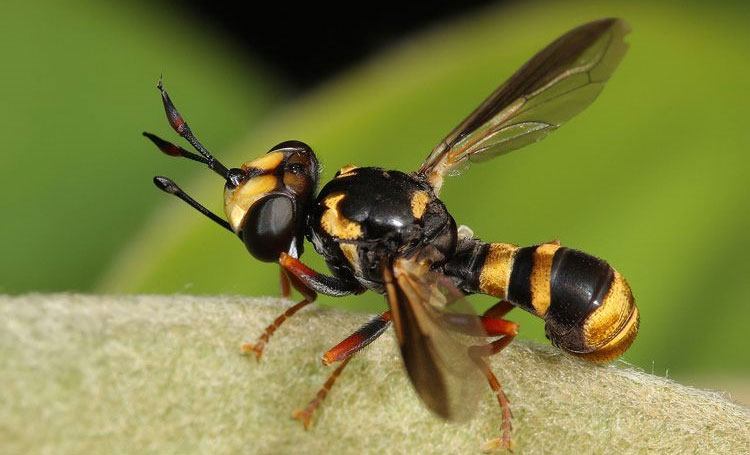Horror parasites make bees to dig their own burial holes
Not simply taking the body, turning the host into a living body or controlling the body and leaving the brain of the host intact, the fly parasite Conopid eats the host from within, forcing the host to fall. Wings and dig buried holes yourself.
In addition to habitat loss and exposure to pesticides, bees also face increased pressure from Conopid fly parasites .
It sounds like a horror film about capturing hostile bodies but the truth is far more cruel.Conopid fly larvae are classified as a parasite and this parasite not only relies on hosts but also kills hosts in the most terrifying and scary way.
Not simply taking the body, turning the host into a living body or controlling the body and leaving the host's brain intact, the Conopid flies eat the host from the inside before forcing the host to fall. Wings on the ground and digging buried holes yourself.

Fly larvae Conopid not only relies on hosts but also kills hosts in the most terrible and scary way.(Illustration)
According to scientific research, the Conopid fly has a very unique way of infection. Adult female flies will lie in flowers that are capable of attracting insects, especially bees that collect chalk.
When a bee flies in close enough distance, the Conopid fly will sneak the opponent in midair. The look is very fast but the movements of the Conopid fly are extremely careful. As soon as the bee's body is touched, the Conopid fly will hit the bee's abdomen, stimulating the bee's abdomen to open and laying an egg in it.
Reaching the goal, the Conopid fly flies away, leaving the victim's bee still unaware that he was infected with the parasite and only survived for a few more days.
It takes two days for the flies to hatch into the larvae. Once hatched into larvae, the Conopid flies begin to eat the flesh and blood of the host bee. Subsequently, over time, the larvae begin to eat the intestinal tissue of the host. Literally, it eats every part of the host bee's organs, while the bee is still alive and endures the extremely painful thing.
After about 10 days, the Conopid larva controls the host bee that falls to the ground, forcing the host to dig a small hole in the ground then crawl into it and kill the host.
Scientists are not sure how the fly-conopid parasite can cause bees to dig their own holes, but according to a theory, the Conopid fly's parasite might be the bee The owner thought he was a queen, ready to hibernate.

Conopid flies not only eat live and control the host, it also affects the behavior of the host thoroughly.(Illustration).
However, making the dead host still unsatisfied, in the warm and safe protection of the victim's body was buried, fly larvae Conopid peacefully developed into a pupa. After a while, it becomes the adult Conopid fly and escapes itself from the shallow grave, ready to feed and begin a cycle of infecting other bees.
The researchers also found that the Conopid fly not only eaten live and controlled the host, it also had a profound effect on the behavior of the host, causing infected insects to tend to spend less time on My team and spend more time to eat.
In addition, researchers also point out that in particular, parasitic bees may not return to the nest. This may be due to physical stress - bees behave strangely when corroded from within. It may also be due to the Conopid fly defense mechanism.
- Traces the parasite to turn bees into living corpses
- Discover how parasites control host behavior
- Mushrooms can save bees
- Horror parasites on the human body
- Horror bees turn the prey into 'living corpses'
- Find out the 'secret' to make honey bees into queen bees
- The secret of bees
- The species of bees disappears, the species is extinct
- The goal is that few people know of burial on trees
- Video: Close-up of the scene of grabbing horror buffalo larvae on the girl's shoulders attracts millions of viewers
- Not only humans, bees are also stressed out for work
- 'Eco-friendly' burial is becoming a trend!
 Why do potatoes have eyes?
Why do potatoes have eyes? 'Tragedy' the world's largest carnivorous life: Death becomes ... public toilet
'Tragedy' the world's largest carnivorous life: Death becomes ... public toilet Tomatoes were once considered 'poisonous' for 200 years
Tomatoes were once considered 'poisonous' for 200 years Detecting microscopic parasites on human face
Detecting microscopic parasites on human face